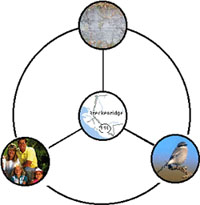
Table of Contents
Executive
Summary
The Biodiversity Management
Plan, Phase I was conducted at the request of the Nature Conservancy Canada
(NCC)- Québec Region. It examines both the ecological importance
and human aspect of a four-hundred-acre site located within the Ottawa
River Valley. The site is considered to be provincially significant habitat
and is slated to become a part of a planned four-thousand-acre nature
reserve. The project will protect important wetland, forest, and pastoral
habitat within the Ottawa River Valley, a primary area of conservation
focus for the NCC. Within this paper, the vulnerable, rare, and special
concern flora and fauna species present on the site, or potentially able
to inhabit the site, are examined in terms of their physical and biological
requirements. Threats and disturbances to these target species are determined,
and recommendations to minimize these threats are discussed. The human
aspect of the site is examined in terms of past, present, and projected
land use. Human threats to the flora, fauna, and habitats of the site
are noted and recommendations to counteract these threats are discussed.
The resources necessary to complete this management plan are discussed,
including: extensive literature reviews, site visits, discussions with
the client and landowners, and development and application of a management
framework.
The NCC project is divided into three phases. This management plan is
necessary in order to complete phase one, acquisition of the entire site.
Phase two includes preservation and management of the habitats present
on the site in order to benefit the vulnerable, rare, and special concern
flora and fauna species present, with additional property purchases. Phase
three includes the creation of a wildlife corridor between a nearby nature
reserve and the Ottawa River, which delineates one boundary of the site.
The site forms an integral part of the larger NCC project because of the
diversity of habitats and species present on and utilizing the site, as
well as its ideal location as a wildlife corridor. The habitats on the
site include grassland, riparian vegetation, forest, and mountainous habitats.
In terms of species, 390 flora species and 190 bird species have been
inventoried on the site. The landowners have additionally noted numerous
amphibians, mammals, and reptiles. On a regional scale, the site is an
ideal species dispersal route between the nearby nature reserve and the
Ottawa River. In a broader context, the site lies in close proximity to
the planned Adirondack to Algonquian Wildlife Corridor, part of the Wildlands
Project and the largest wildlife preservation project in eastern North
America.
Of the twenty-four species examined in this management plan, seven are
determined to be priority species for the NCC based on their presence
or ability to inhabit the site, the seriousness and immediacy of the threats
facing these species, and the status of these species. Several actions
are recommended in order to address the priority species and their required
habitats, including: managing the grazing regime of the pasture, managing
woody vegetation in both the pasture and forest, managing populations
of other species (e.g. invasive and disperser species), purchasing surrounding
property, and managing human presence on the site.
Furthermore, we outline a management framework for the site. We recommend
that the management option for the site be IUCN Category IV: Species/Habitat
Management Area. We recognize that threats must be reduced and habitats
must be maintained in order to meet the requirements of the priority flora
and fauna species. We recommend that this management be adaptive in order
to allow for flexibility in order to deal with uncertainties and possible
changes in physical, biological, and human aspects. However, we recognize
that within the adaptive management approach, one must set certain limits
and recognize that species and habitats need varying time periods to respond
and adjust to any implemented actions.

